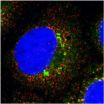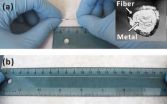Spread of cancer cells may be slowed by targeting of protein
2012-12-18
(Press-News.org) HERSHEY, Pa.--The spread of cancer cells may be slowed by targeting the protein km23-1, according to researchers at Penn State College of Medicine.
A motor protein that transports cargo within the cell, km23-1 is also involved in the movement or migration of cells. Migration is necessary for cancer to spread, so understanding this cell movement is important for development of better cancer treatments.
Kathleen Mulder, Ph.D., professor, biochemistry and molecular biology, looked for partner proteins that bind to and cooperate with km23-1 during cell movement, which turned out to include factors that can control proteins actin and RhoA.
"Cell migration is an important aspect of the process of a tumor spreading," Mulder said. "Changes in this process transform tumor cells from local, noninvasive, confined cells to the migrating, metastatic cancer cells."
Cells move through the body using the protein actin, which forms the structural frame of the cell, called the cytoskeleton. The actin creates a protrusion in the cell membrane by forming strands of thread-like fibers on the leading edge of the cell, pushing the cell forward. Several identified proteins regulate the reorganization of the cytoskeleton and are more active in several types of cancers.
Overexpression of km23-1 increases actin fiber formation, whereas when km23-1 is diminished, RhoA activity decreases. RhoA is known to be an important switch, activating processes in migration.
"By knowing that RhoA activity was decreased when km23-1 was reduced, we infer that km23-1 is needed for the regulation of these switches and has a role in cell movement," Mulder said.
To test this in the lab, km23-1 was reduced in a sample of human colon cancer cells. When km23-1 was diminished, cancer cells migrated less. More research needs to be done, but km23-1 may be a promising target for anti-metastatic drugs and cancer therapies to slow the spread of the disease.
"By inhibiting km23-1, you inhibit events that contribute to the cells spreading to other parts of the body," Mulder said.
###
Results were reported in Biochemical and Biophysical Research Communications.
Other researchers are Qunyan Jin, Nageswara R. Pulipati, Cory M. Staub, of the Department of Biochemistry and Molecular Biology, Penn State College of Medicine; and Weidong Zhou and Lance A. Liotta, Center for Applied Proteomics and Molecular Medicine, George Mason University.
Funding was provided by the National Institutes of Health.
ELSE PRESS RELEASES FROM THIS DATE:
UNC researchers discover how hepatitis C virus reprograms human liver cells
2012-12-18
Chapel Hill, NC – CHAPEL HILL – Hepatitis C virus has evolved to invade and hijack the basic machinery of the human liver cell to ensure its survival and spread. Researchers at the University of North have discovered how hepatitis C binds with and repurposes a basic component of cellular metabolism known as a microRNA to help protect and replicate the virus.
In a paper published online in the Proceedings of the National Academy of Sciences Dec. 17, researchers in the laboratory of Stanley M. Lemon, MD, professor of medicine and microbiology and immunology and member of ...
Long-terms benefits follow brain surgery for certain forms of epilepsy
2012-12-18
DETROIT – Brain surgery for certain difficult forms of epilepsy often reduces or eliminates seizures for more than 15 years after the procedure, according to new research by neurologists at Henry Ford Hospital.
Drugs are not effective in controlling seizures in 30 out of 100 people with epilepsy, and resective surgery is the most common alternative treatment. During resective surgery, the portion of the brain responsible for the seizures is removed, usually reducing their frequency and sometimes eliminating them.
"Our study shows that a significant number of patients ...
Long-term survival after less-invasive repair of abdominal aneurysm same as with 'open' procedure
2012-12-18
Despite earlier signs that a less-invasive surgery is safer and better than "open" operations to repair potentially lethal abdominal aortic aneurysms, a study led by a Johns Hopkins professor shows survival rates after four years are similar for both procedures.
In an extended follow-up of patients in the OVER (Open Versus Endovascular Repair) Trial, researchers found that, contrary to expectations, the two procedures carried about the same long-time survival after four years, even though survival was higher in the endovascular group at the two-year mark. Moreover, among ...
Reproductive Health Matters announces publication of its themed issue
2012-12-18
Amsterdam, December 18, 2012 - Sexual and reproductive morbidities are not a priority in health policy. They do not feature among donors favourite health initiatives and remain outside the global health agenda. In many parts of the world practice is stubbornly failing to catch up with national policies, leaving shortfalls in every area of care. This, despite the enormous impact such morbidities have on the lives of women, men and their families, is something that is illustrated in a number of papers published in the latest issue of Reproductive Health Matters (RHM) which ...
Evidence insufficient to recommend routine antibiotics for joint replacement patients
2012-12-18
Rosemont, Ill. - The American Academy of Orthopaedic Surgeons (AAOS), and the American Dental Association (ADA) found that there is insufficient evidence to recommend the routine use of antibiotics for patients with orthopaedic implants to prevent infections prior to having dental procedures because there is no direct evidence that routine dental procedures cause prosthetic joint infections.
The AAOS and ADA's recommendations are based on a collaborative evidence-based clinical practice guideline that focuses on the possible linkage between orthopaedic implant infection ...
Study of pipestone artifacts overturns a century-old assumption
2012-12-18
CHAMPAIGN, lll. — In the early 1900s, an archaeologist, William Mills, dug up a treasure-trove of carved stone pipes that had been buried almost 2,000 years earlier. Mills was the first to dig the Native American site, called Tremper Mound, in southern Ohio. And when he inspected the pipes, he made a reasonable – but untested – assumption. The pipes looked as if they had been carved from local stone, and so he said they were. That assumption, first published in 1916, has been repeated in scientific publications to this day. But according to a new analysis, Mills was wrong.
In ...
Researchers use liquid metal to create wires that stretch 8 times their original length
2012-12-18
Researchers from North Carolina State University have created conductive wires that can be stretched up to eight times their original length while still functioning. The wires can be used for everything from headphones to phone chargers, and hold potential for use in electronic textiles.
To make the wires, researchers start with a thin tube made of an extremely elastic polymer and then fill the tube with a liquid metal alloy of gallium and indium, which is an efficient conductor of electricity.
"Previous efforts to create stretchable wires focus on embedding metals ...
Reappraisal defuses strong emotional responses to Israel-Palestine conflict
2012-12-18
Reappraisal is a widely-used cognitive strategy that can help people to regulate their reactions to emotionally charged events. Now, new research suggests that reappraisal may even be effective in changing people's emotional responses in the context of one of the most intractable conflicts worldwide: the Israeli-Palestinian conflict.
"Negative intergroup emotions play a crucial role in decisions that perpetuate intractable conflicts," observes lead researcher Eran Halperin of the New School of Psychology at the Interdisciplinary Center in Israel.
With this in mind, ...
A swoosh in space: Merry Christmas from Hubble
2012-12-18
Planetary nebulae represent a final brief stage in the life of a star like the Sun. While consuming the last of the fuel in its core, the star expels a large portion of its outer regions, which then heats up and glows brightly, showing intricate structures that scientists are still trying to fully understand. The structure visible within NGC 5189 is particularly dramatic, and Hubble's image of the nebula is by far the most detailed yet made of this object [1].
Hubble has been a key tool for studying planetary nebulae for years, and many of its images have become famous. ...
EARTH: Here comes the solar maximum
2012-12-18
Alexandria, VA – In 1859, the largest recorded coronal mass ejection (CME) from the sun, known as the Carrington Event, disrupted what little electrical technology was used at the time. Back then, that meant the temporary disruption of the telegraph system. Today, without an effective warning mechanism in place, a solar storm of that magnitude could wreak havoc on our technology-dependent world. And with the solar maximum predicted to occur later this year, scientists and policymakers are scrambling to prepare us for when the next big solar storm hits.
CMEs occur when ...



